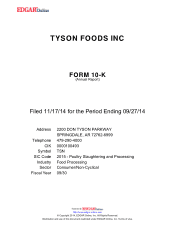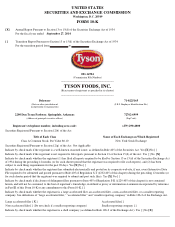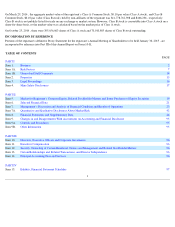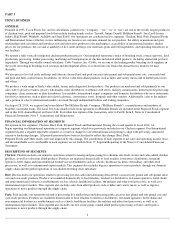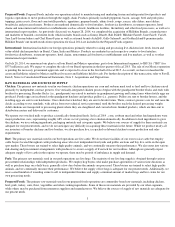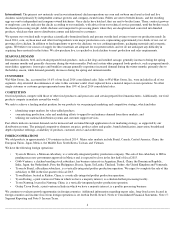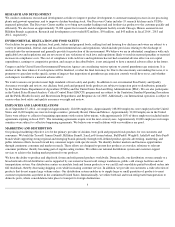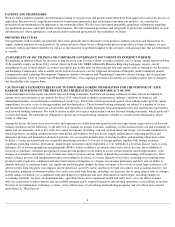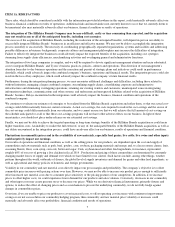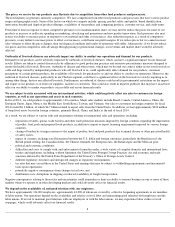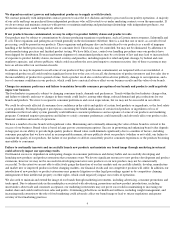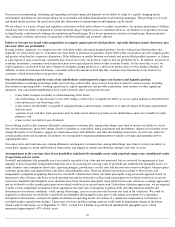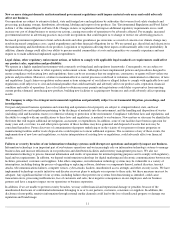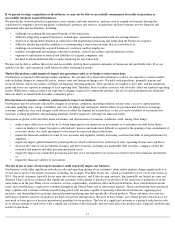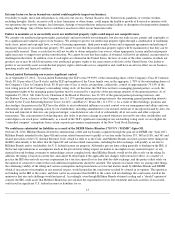Tyson Foods 2014 Annual Report Download - page 5
Download and view the complete annual report
Please find page 5 of the 2014 Tyson Foods annual report below. You can navigate through the pages in the report by either clicking on the pages listed below, or by using the keyword search tool below to find specific information within the annual report.
Prepared Foods: Prepared Foods includes our operations related to manufacturing and marketing frozen and refrigerated food products and
logistics operations to move products through the supply chain. Products primarily include pepperoni, bacon, sausage, beef and pork pizza
toppings, pizza crusts, flour and corn tortilla products, appetizers, prepared meals, ethnic foods, soups, sauces, side dishes, meat dishes,
breadsticks and processed meats. Products are marketed domestically to food retailers, foodservice distributors, restaurant operators, hotel
chains and noncommercial foodservice establishments such as schools, healthcare facilities, the military and other food processors, as well as to
international export markets. As previously discussed, on August 28, 2014, we completed the acquisition of Hillshire Brands, a manufacturer
and marketer of branded, convenient foods which includes brands such as Jimmy Dean®, Ball Park®, Hillshire Farm®, State Fair®, Van's®,
Sara Lee® frozen bakery and Chef Pierre® pies as well as artisanal brands Aidells®, Gallo Salame®, and Golden Island® premium jerky.
Hillshire Brands' one month results from operations for fiscal 2014 are included in the Prepared Foods segment.
International: International includes our foreign operations primarily related to raising and processing live chickens into fresh, frozen and
value-added chicken products in Brazil, China, India and Mexico. Products are marketed in each respective country to food retailers,
foodservice distributors, restaurant operators, hotel chains, noncommercial foodservice establishments and live markets, as well as to other
international export markets.
On July 28, 2014, we announced our plan to sell our Brazil and Mexico operations, part of our International segment, to JBS SA ("JBS") for
$575 million in cash. We expect to complete the sale of our Brazil operation in the first quarter of fiscal 2015. The sale of our Mexico operation
is pending the necessary government approvals and is expected to close in the first half of fiscal 2015. As a result, we have reclassified the
assets and liabilities related to Mexico and Brazil to assets and liabilities held for sale. For further description of this transaction, refer to Part II,
Item 8, Notes to Consolidated Financial Statements, Note 3: Acquisitions and Dispositions.
RAW MATERIALS AND SOURCES OF SUPPLY
Chicken: The primary raw materials used in our domestic chicken operations are corn and soybean meal used as feed and live chickens raised
primarily by independent contract growers. Our vertically-integrated chicken process begins with the grandparent breeder flocks and ends with
broilers for processing. Breeder flocks (i.e., grandparents) are raised to maturity in grandparent growing and laying farms where fertile eggs are
produced. Fertile eggs are incubated at the grandparent hatchery and produce pullets (i.e., parents). Pullets are sent to breeder houses, and the
resulting eggs are sent to our hatcheries. Once chicks have hatched, they are sent to broiler farms. There, contract growers care for and raise the
chicks according to our standards, with advice from our technical service personnel, until the broilers reach the desired processing weight.
Adult chickens are transported to processing plants where they are slaughtered and converted into finished products, which are then sent to
distribution centers and delivered to customers.
We operate our own feed mills to produce scientifically-formulated feeds. In fiscal 2014 , corn, soybean meal and other feed ingredients were
major production costs, representing roughly 68% of our cost of growing a live chicken domestically. In addition to feed ingredients to grow
the chickens, we use cooking ingredients, packaging materials and cryogenic agents. We believe our sources of supply for these materials are
adequate for our present needs, and we do not anticipate any difficulty in acquiring these materials in the future. While we produce nearly all
our inventory of breeder chickens and live broilers, we also purchase live, ice-packed or deboned chicken to meet production and sales
requirements.
Beef: The primary raw materials used in our beef operations are live cattle. We do not have facilities of our own to raise cattle but employ
cattle buyers located throughout cattle producing areas who visit independent feed yards and public auctions and buy live cattle on the open
spot market. These buyers are trained to select high quality animals, and we continually measure their performance. We also enter into various
risk-sharing and procurement arrangements with producers to secure a supply of livestock for our facilities. Although we generally expect
adequate supply of live cattle in the regions we operate, there may be periods of imbalance in supply and demand.
Pork: The primary raw materials used in our pork operations are live hogs. The majority of our live hog supply is obtained through various
procurement relationships with independent producers. We employ hog buyers who make purchase agreements of various time durations as
well as purchase hogs on a daily basis, generally a few days before the animals are processed. These buyers are trained to select high quality
animals, and we continually measure their performance. We believe the supply of live hogs is adequate for our present needs. Additionally, we
raise a small number of weanling swine to sell to independent finishers and supply a minimal amount of market hogs and live swine for our
own processing needs.
Prepared Foods: The primary raw materials used in our prepared foods operations are commodity based raw materials, including chicken,
beef, pork, turkey, corn, flour, vegetables and other cooking ingredients. Some of these raw materials are provided by our other segments,
while others may be purchased from numerous suppliers and manufacturers. We believe the sources of supply of raw materials are adequate for
our present needs.
3

